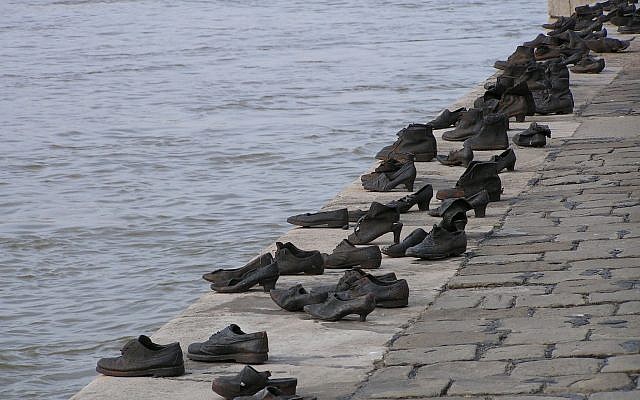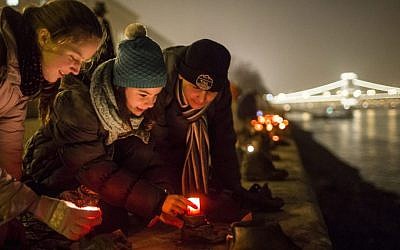
IF BONES ARE FOUND, THEY’LL BE BROUGHT TO ISRAEL FOR BURIAL
Israeli divers to search for Holocaust victims’ remains in the Danube
Thousands of Jews were murdered on banks of Hungarian river in 1944. Now Budapest is backing Zaka rescuers’ project to scouring river for their remains
A team of Israeli divers will search Hungary’s Danube River for the remains of Holocaust victims, Israeli Interior Minister Aryeh Deri announced Monday.
Deri said that following a meeting he had with Sandor Pinter in Budapest, the Hungarian interior minister agreed to allow rescuers from the Zaka emergency service and victim identification organization to scour the river for bones of Jews who were shot and thrown into the waters of the Danube in Budapest during the Holocaust.
“If the martyrs’ bones are found, they will be brought to Israel for burial,” Deri said in a video statement in front of the “Shoes on the Danube Bank” Holocaust memorial in Budapest.
The “Shoes on the Danube Bank” memorial consists of 60 pairs of period shoes made out of iron to commemorate the Jews who were brought to the spot by members of the Arrow Cross. They were ordered to remove their shoes and then were shot so that their bodies fell into the river.Thousands of Jews were murdered on the banks of the Danube by members of the Hungarian Nazi-allied Arrow Cross Party in 1944. The victims were among the roughly 600,000 Hungarian Jews wiped out during the Holocaust.
In 2011, human remains were discovered during construction work on the Margaret Bridge overlooking the Danube.
Forensic examinations of the fragments indicated they belonged to more than 20 different people, including women and children, who had probably died during the war.
But as investigations into the victims’ identity and cause of death proved inconclusive, authorities soon closed the case and removed the bones to storage where they remained until an anthropology student ran DNA tests on them in August 2015.

The results revealed that at least nine of 15 samples from the bones were almost certainly Ashkenazi Jews from Europe, while the other six could also be of that ethnicity.
With mounting evidence that the bones were probably those of Jewish victims of the Arrow Cross, Jewish religious leaders called for their immediate interment in a Jewish cemetery.
Authorities initially preferred a non-denominational burial, given the possibility — albeit smaller — that the bones may have belonged to non-Jews killed when Nazi German explosives destroyed part of Margaret Bridge in November 1944.
Eventually, the sides agreed that the remains would be buried at a Jewish cemetery in Budapest.
The affair added fuel to a growing debate over the degree of Hungary’s collaboration with the Nazis.
Jewish groups have sometimes accused Prime Minister Viktor Orban’s right-wing government, in power since 2010, of downplaying Hungary’s role in the Holocaust during which some 600,000 Hungarian Jews perished.
Approximately half a million people or every third victim in Auschwitz was a Hungarian Jew.
AFP contributed to this report